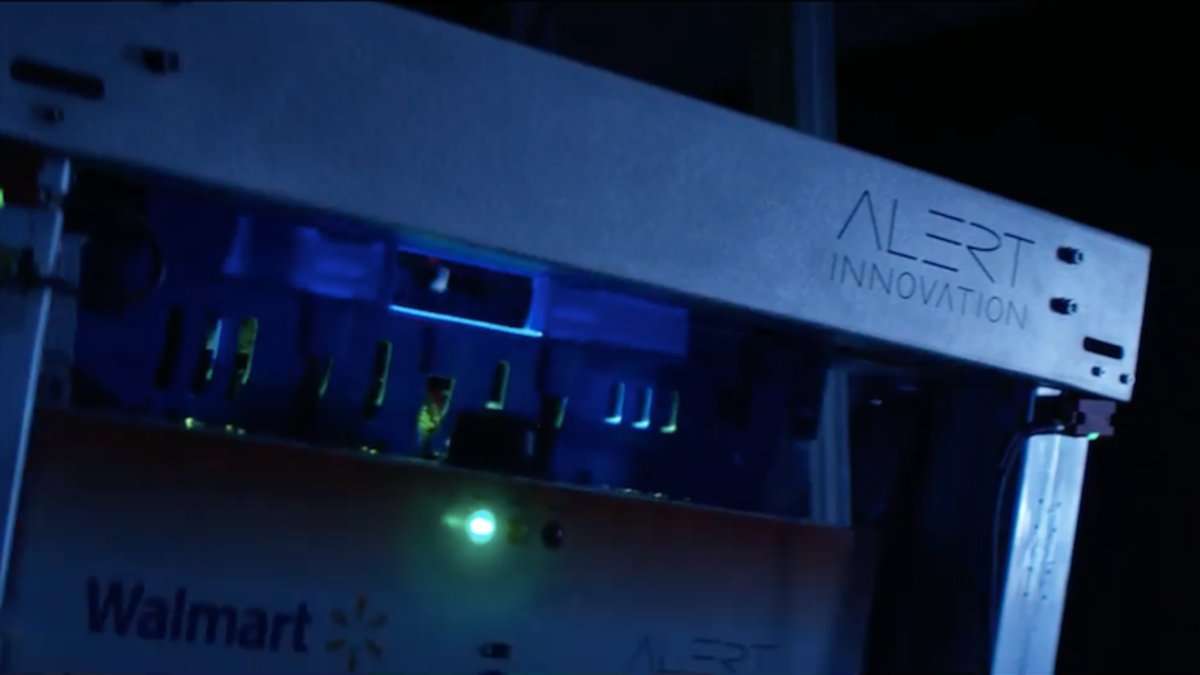The Alphabot is a automated fulfillment system that uses humans and robots to put together Walmart’s online grocery orders. Screenshot : Alert Innovation
Walmart has unveiled a new initiative that aims to make in-store fulfillment, one of the biggest challenges for its online grocery business, more efficient. Say hello to Alphabot, a robotic fulfillment system that uses human labor and robot speed to pick more than 800 products per hour.
This week, The Wall Street Journal published an in-depth look at Walmart’s Alphabot system in Salem, New Hampshire. At its core, Alphabot is a 20,000 square foot automated warehouse that uses humans and a fleet of robots to put together customers’ grocery orders as fast as possible. Once the robots collect all the products, humans pack up the groceries and take them to the client’s car.
The system was designed by Alert Innovation, a Massachusetts-based startup that started talking to Walmart about building an automation system in 2016.
Alphabot is an important project for Walmart, which allows shoppers to pick up their online orders curbside at more than 3,000 stores nationwide, according to Bloomberg. By comparison, Walmart only offered curbside pickup for about 400 stores in 2016. It also offers home grocery delivery at 1,000 of its stores.
“This is going to be a transformative impact to Walmart’s supply chain,” Brian Rother, Walmart’s senior manager of pickup automation and digital operations, told Bloomberg in an interview. “Alphabot is streamlining the order process, allowing associates to do their jobs with greater speed and efficiency.”
Speed and efficiency are some of the problems Walmart and other companies struggle with when it comes to fulfillment. The current fulfillment model for online grocery orders is labor intensive, requiring dozens of employees to run around the store to gather everything on the customer’s list and more employees to pick up the order and take it to the customer’s vehicle.
Comfort is another issue. The human picking model creates more traffic for in-store shoppers, who have to avoid the multiple pickers rushing to fulfill online orders.
However, the Alphabot system solves these problems. For one, the warehouse is separate from the store. In addition, the robots, which are each around two feet wide, are the ones that run around the warehouse and gather the products. And they do this much faster. As mentioned above, the robots can pick more than 800 products per hour. The number corresponds to the products picked per workstation, which is operated by a human.
By comparison, according to Alert Innovation, a human store worker can pick around 80 products from store shelves in an hour.
Does this mean that Alphabot can operate entirely without humans? Not yet. Human workers stock up the 24-foot-high machine every day with the most ordered online items, which include refrigerated and frozen foods. Additionally, fresh produce, which can be tricky for delivery because of its short shelf life, is still hand picked by humans in the store.
Considering that Alphabot is, in a way, a hybrid system, or a system that needs both humans and robots to work, its immediate effect on human workers isn’t clear. Although these kinds of automated systems always start with a mix of humans and robots, they tend to gradually move towards being operated by robots only.
For the system in Salem, Walmart told the Wall Street Journal that it hired 10 additional people to keep the system stocked and to pick fresh produce from the store. The Alphabot in Salem is currently working at only 20% of its capacity, and fulfills approximately 170 orders a day.
Nonetheless, the store’s leadership has one thing clear: This is just the beginning for Alphabot.
“We will continue to grow this aggressively,” Tom Ward, Walmart’s senior vice president of digital operations, told Bloomberg in an interview. “You cannot grow by picking one order in one shopping cart at a time.”
Walmart currently has another scaled-down version of the Alphabot system in a supercenter near its headquarters in Arkansas. It plans to begin construction on two more systems at its stores in Mustang, Oklahoma and Burbank, California.

Adroite on January 13rd, 2020 at 04:39 UTC »
I get that this is how... things are likely to continue to go. But ya know, living alone and working an 8-6 job many days of the week, going to the store is sometimes my only time to 'get out' and do something. Feels oddly unsettling that in the future, there will be so few reasons to go out, and maybe... not many places to go if you do.
lordofhell78 on January 13rd, 2020 at 00:13 UTC »
I worked at one of their distribution centers. It was hell on Earth for everybody involved so this might be a good thing. Sadly it was the only Walmart job that actually pays a living wage but you destroy your body in the process.
roo-ster on January 12nd, 2020 at 23:45 UTC »
That article does say 20,000 square feet but that must be a typo. 200,000 square feet would be a more reasonable size.